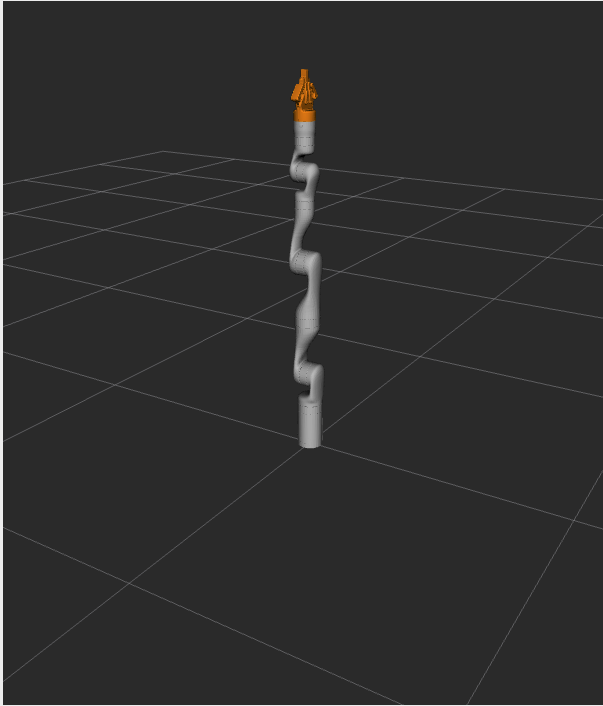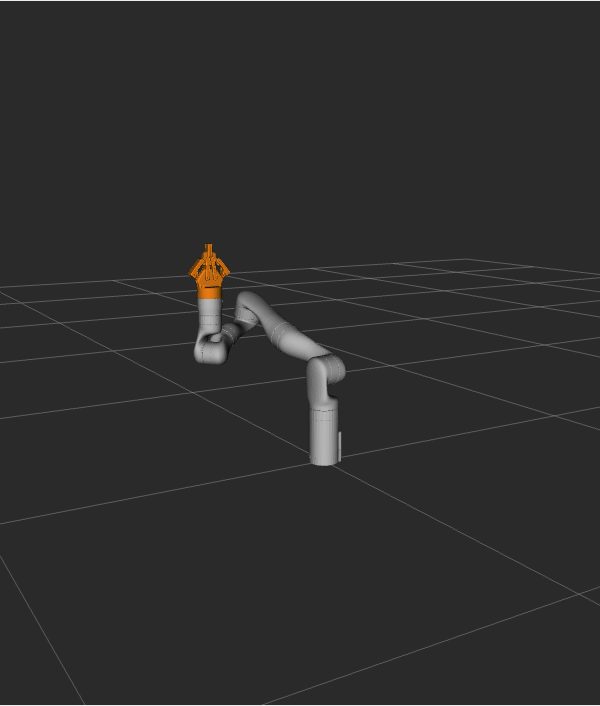你的第一个 C++ MoveIt 项目
本教程将指导您使用 MoveIt 编写第一个 C++ 应用程序。
警告:MoveIt 中的大多数功能将无法正常工作,因为完整的 Move Group 功能需要额外的参数。要进行完整设置,请继续阅读 Move Group C++ 接口教程。
先决条件
如果您尚未完成此操作,请确保您已完成 入门 中的步骤。
本教程假设您了解 ROS 2 的基础知识。
为了做好准备,请完成 官方 ROS 2 教程 直到“编写简单的发布者和订阅者 (C++)”。
步骤
1 创建包
打开终端并“获取 ROS 2 安装 <https://docs.ros.org/en/rolling/Tutorials/Configuring-ROS2-Environment.html>”以便“ros2”命令可以正常工作。
导航到您在 :doc:“入门教程 </doc/tutorials/getting_started/getting_started>”中创建的“ws_moveit”目录。
将目录更改为“src”目录,因为这是我们放置源代码的地方。
使用 ROS 2 命令行工具创建一个新包:
ros2 pkg create \
--build-type ament_cmake \
--dependencies moveit_ros_planning_interface rclcpp \
--node-name hello_moveit hello_moveit
输出结果显示它在新目录中创建了一些文件。
请注意,我们添加了“moveit_ros_planning_interface”和“rclcpp”作为依赖项。 这将在“package.xml”和“CMakeLists.txt”文件中创建必要的更改,以便我们可以依赖这两个包。
在您最喜欢的编辑器中打开为您创建的新源文件“ws_moveit/src/hello_moveit/src/hello_moveit.cpp”。
2 创建 ROS 节点和执行器
第一段代码有点样板化,但您应该习惯从 ROS 2 教程中看到它。
#include <memory>
#include <rclcpp/rclcpp.hpp>
#include <moveit/move_group_interface/move_group_interface.h>
int main(int argc, char * argv[])
{
// Initialize ROS and create the Node
rclcpp::init(argc, argv);
auto const node = std::make_shared<rclcpp::Node>(
"hello_moveit",
rclcpp::NodeOptions().automatically_declare_parameters_from_overrides(true)
);
// Create a ROS logger
auto const logger = rclcpp::get_logger("hello_moveit");
// Next step goes here
// Shutdown ROS
rclcpp::shutdown();
return 0;
}
2.1 构建并运行
在继续之前,我们将构建并运行该程序,以确保一切正常。
将目录更改回工作区目录“ws_moveit”并运行以下命令:
colcon build --mixin debug
成功后,打开一个新终端,然后在新终端中获取工作区环境脚本,以便我们可以运行我们的程序。
cd ~/ws_moveit
source install/setup.bash
运行你的程序并查看输出。
ros2 run hello_moveit hello_moveit
程序应运行并退出,不会出现错误。
2.2 检查代码
顶部包含的标头只是一些标准 C++ 标头以及我们稍后将使用的 ROS 和 MoveIt 的标头。
之后,我们有正常调用来初始化 rclcpp,然后我们创建我们的节点。
auto const node = std::make_shared<rclcpp::Node>(
"hello_moveit",
rclcpp::NodeOptions().automatically_declare_parameters_from_overrides(true)
);
第一个参数是 ROS 用来命名唯一节点的字符串。 第二个参数是 MoveIt 所必需的,因为我们使用 ROS 参数的方式。
接下来,我们 `创建一个名为“hello_moveit”的记录器<https://docs.ros.org/en/humble/Tutorials/Demos/Logging-and-logger-configuration.html>`_,以使我们的日志输出井然有序且可配置。
// Create a ROS logger
auto const logger = rclcpp::get_logger("hello_moveit");
最后,我们有关闭 ROS 的代码。
// Shutdown ROS
rclcpp::shutdown();
return 0;
3 使用 MoveGroupInterface 进行计划和执行
在“下一步从这里开始”的注释处添加以下代码:
// Create the MoveIt MoveGroup Interface
using moveit::planning_interface::MoveGroupInterface;
auto move_group_interface = MoveGroupInterface(node, "manipulator");
// Set a target Pose
auto const target_pose = []{
geometry_msgs::msg::Pose msg;
msg.orientation.w = 1.0;
msg.position.x = 0.28;
msg.position.y = -0.2;
msg.position.z = 0.5;
return msg;
}();
move_group_interface.setPoseTarget(target_pose);
// Create a plan to that target pose
auto const [success, plan] = [&move_group_interface]{
moveit::planning_interface::MoveGroupInterface::Plan msg;
auto const ok = static_cast<bool>(move_group_interface.plan(msg));
return std::make_pair(ok, msg);
}();
// Execute the plan
if(success) {
move_group_interface.execute(plan);
} else {
RCLCPP_ERROR(logger, "Planning failed!");
}
3.1 构建并运行
和之前一样,我们需要先构建代码,然后才能运行它。
在工作区目录“ws_moveit”中,运行以下命令:
colcon build --mixin debug
成功后,我们需要重用上一个教程中的演示启动文件来启动 RViz 和 MoveGroup 节点。 在单独的终端中,获取工作区,然后执行以下命令:
ros2 launch moveit2_tutorials demo.launch.py
然后在“MotionPlanning/Planning Request”下的“Displays”窗口中,取消选中“Query Goal State”框。

在第三个终端中,获取工作区并运行您的程序。
ros2 run hello_moveit hello_moveit
这应该会导致 RViz 中的机器人移动并最终处于以下姿势:

注意,如果您运行节点“hello_moveit”而不先启动演示启动文件,它将等待10秒,然后打印此错误并退出。
[ERROR] [1644181704.350825487] [hello_moveit]: Could not find parameter robot_description and did not receive robot_description via std_msgs::msg::String subscription within 10.000000 seconds.
这是因为 demo.launch.py 启动正在启动提供机器人描述的 MoveGroup 节点。
构造 MoveGroupInterface 时,它会查找发布带有机器人描述的主题的节点。
如果在 10 秒内找不到该节点,它会打印此错误并终止程序。
3.2 检查代码
我们要做的第一件事是创建“MoveGroupInterface”。 此对象将用于与“move_group”交互,这使我们能够规划和执行轨迹。 请注意,这是我们在此程序中创建的唯一可变对象。 另一件需要注意的事情是我们在此处创建的“MoveGroupInterface”对象的第二个参数:“manipulator”。 这是机器人描述中定义的关节组,我们将使用此“MoveGroupInterface”对其进行操作。
using moveit::planning_interface::MoveGroupInterface;
auto move_group_interface = MoveGroupInterface(node, "manipulator");
然后,我们设置目标姿势和计划。请注意,仅设置目标姿势(通过“setPoseTarget”)。 起始姿势隐式是关节状态发布者发布的位置,可以使用“MoveGroupInterface::setStartState*”函数系列进行更改(但本教程中不提供此功能)。
关于下一节,还有一点需要注意,即使用 lambda 来构造消息类型“target_pose”和规划。 这是现代 C++ 代码库中常见的一种模式,它支持以更具声明性的风格进行编写。 有关此模式的更多信息,请参阅本教程末尾的几个链接。
// Set a target Pose
auto const target_pose = []{
geometry_msgs::msg::Pose msg;
msg.orientation.w = 1.0;
msg.position.x = 0.28;
msg.position.y = -0.2;
msg.position.z = 0.5;
return msg;
}();
move_group_interface.setPoseTarget(target_pose);
// Create a plan to that target pose
auto const [success, plan] = [&move_group_interface]{
moveit::planning_interface::MoveGroupInterface::Plan msg;
auto const ok = static_cast<bool>(move_group_interface.plan(msg));
return std::make_pair(ok, msg);
}();
最后,如果规划成功,我们就执行计划,否则,我们就记录错误:
// Execute the plan
if(success) {
move_group_interface.execute(plan);
} else {
RCLCPP_ERROR(logger, "Planning failed!");
}
摘要
您创建了一个 ROS 2 包并使用 MoveIt 编写了您的第一个程序。
您了解了如何使用 MoveGroupInterface 来规划和执行移动。
Here is a copy of the full hello_moveit.cpp source at the end of this tutorial.
进一步阅读
我们使用 lambda 来将对象初始化为常量。
这被称为 IIFE 技术。 从 C++ Stories 中了解有关此模式的更多信息。 - 我们还将我们可以声明的所有内容声明为 const。 在此处阅读有关 const 的更多实用性。
下一步
在下一个教程 在 RViz 中可视化 中,您将扩展此处构建的程序以创建可视化标记,以便更轻松地理解 MoveIt 正在做什么。